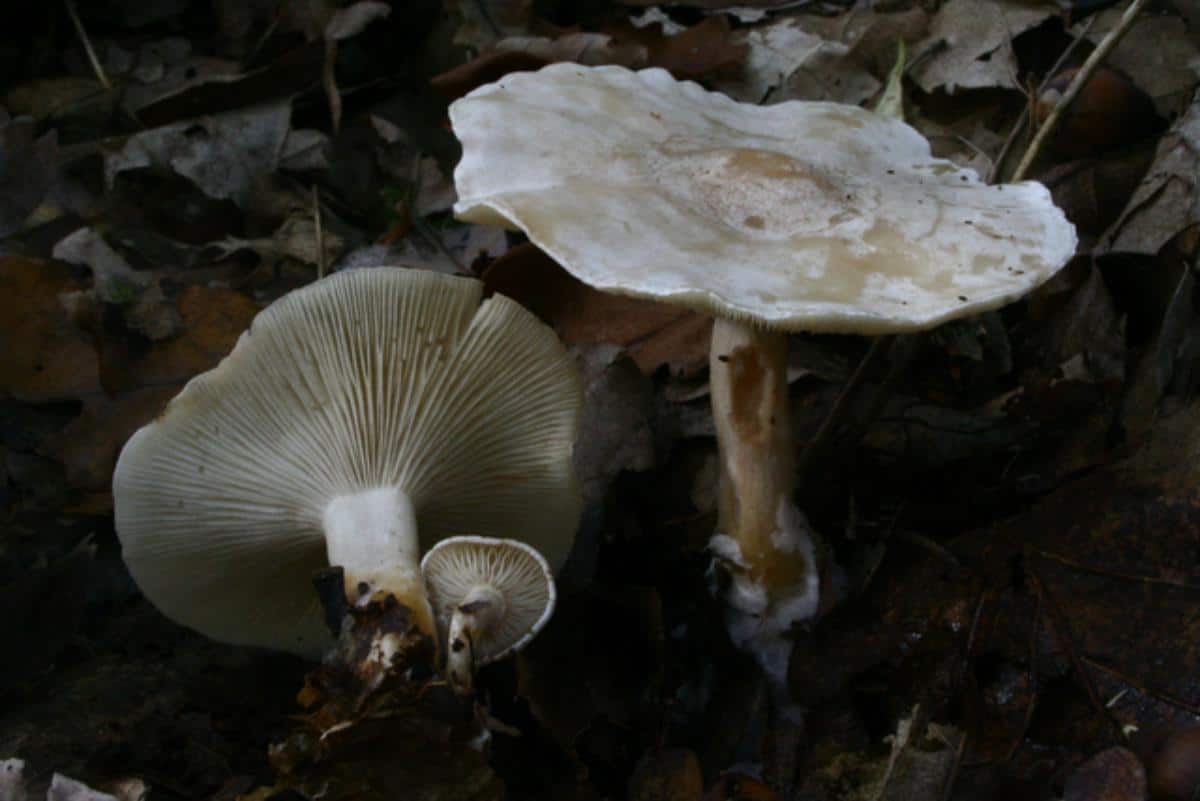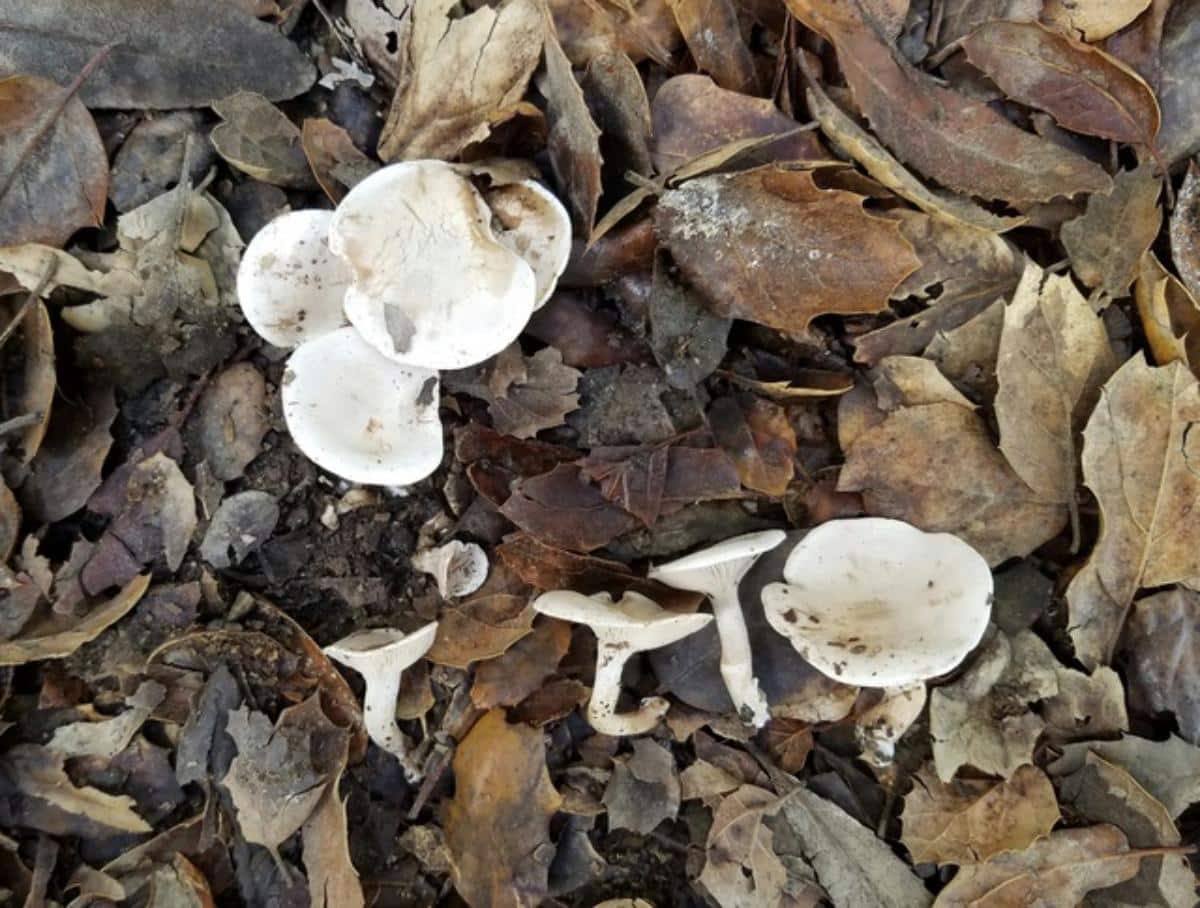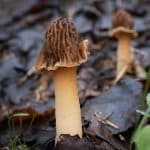Fool’s Funnel is a testament to the captivating and sometimes treacherous world of mushrooms. Remember, identification is paramount when venturing into the mushroom kingdom. With knowledge about Fool’s Funnel’s (Clitocybe rivulosa or C. dealbata) distinctive features, habitat, and toxic properties, you can ensure you don’t make any terrible mistakes.
- Scientific Name: Clitocybe rivulosa, Clitocybe dealbata
- Common Names: Fool’s Funnel, False Champignon, sweating mushroom
- Habitat: Pastures and meadows
- Edibility: Poisonous

Jump to:
All About Fool’s Funnel
Fool’s funnel grows in pastures and grasslands, making it a widely encountered species. It also often appears in large “fairy” rings or arcs, which also draws people to it.
There is debate as to whether Fool’s Funnel has two species, Clitocybe rivulosa and Clitocybe dealbata. Most experts agree now that they are the same species, with C. rivulosa being the correct name. However, some still differentiate the mushroom based on habitat – C. rivulosa in sandy grasslands and C. dealbata in meadows. In guidebooks and online sources, you may see either name applied to this mushroom. For our purposes, we are treating them as the same.
Side note: Clitocybe pronunciation rhymes with “Toss a bee.”

Fool’s Funnel Toxicity
This fungus contains the toxin muscarine, which can have severe consequences if ingested. Symptoms of muscarine poisoning include excessive salivation, sweating, and lacrimation (tear production) within half an hour of consumption. This is known as SLUDGE syndrome.
Larger doses can lead to abdominal pain, nausea, diarrhea, blurred vision, and labored breathing. While Fool’s Funnel poisoning deaths are rare, individuals with pre-existing health conditions are at higher risk. It is essential to exercise utmost caution and refrain from consuming this deadly mushroom.

Identification Guide to Fool’s Funnel
Season
This mushroom appears from late summer to late autumn.
Habitat
Fool’s funnel can be found in various habitats, adding an element of surprise to its discovery. This toxic species often emerges in people-oriented places such as lawns, parks, and roadsides. It has a particular affinity for sandy soil.
This mushroom grows from the ground, never from trees or wood. It appears singularly or in vast scattered groupings. Finding this species in large arcs or a fairy ring with dozens of specimens is not uncommon.

Identification
Cap
The cap of Fool’s Funnel measures around 1-2.5 inches in diameter. Initially convex (rounded), it gradually flattens out, often taking on a distinctive funnel shape with the edges rolled under slightly. The surface of the cap is powdered white, sometimes displaying concentric rings or blotch marks that reveal the darker buff-colored flesh beneath. This blotching happens when the mushroom is wet; the excess moisture brings out the cap blotting. When dry, the cap is generally uniformly white.
Stem
The stem of Fool’s Funnel is approximately .75- 1.5 inches long and shares the same color as the cap. It is often slightly woolly at the base.
Gills
The gills of this mushroom are white or whitish-buff, running decurrently down the stem. They appear crowded and gradually turn more buff-colored as the mushroom ages.

Flesh
White and unchanging when cut or bruised.
Odor and Taste
There is a slightly sweet but not very distinctive smell. The taste is indistinct.
Spore Print
Fool’s funnel produces a white spore print.


Fool’s Funnel Lookalikes
The mushroom kingdom is full of doppelgängers, and Fool’s Funnel is no exception. Several species bear a striking resemblance to this mushroom, making proper identification crucial, especially since some of the lookalikes are edible and valued.
Fairy Ring Champignon (Marasmius oreades)
One of the most common lookalikes to Fool’s Funnel is the Fairy Ring mushroom. This edible mushroom shares a similar appearance, often growing in fairy rings in meadows and parks. However, it can be distinguished by its thinner cap flesh which is more tan or brown than the white or gray of the fool’s funnel. Fairy ring mushrooms also have more widely spaced gills that do not run down the stem.
Foragers must exercise caution and ensure they differentiate between the two species before indulging in their harvest. It is not uncommon for these two mushrooms to grow in close proximity or even in the same fairy ring. If you forage fairy ring mushrooms, always inspect each mushroom individually and never make assumptions.

Sweetbread Mushroom (Clitopilus prunulus)
This all-white mushroom is edible and grows across North America. It is easily confused with fool’s funnel if foragers aren’t attentive. The sweetbread mushroom, though, smells like raw pastry (or cucumber), and while its gills are white, they often develop a pinkish tinge with age.
The other primary difference is habitat. While the fool’s funnel grows in grassy areas like meadows and parks, the sweetbread mushroom prefers wooded areas.

Fools Funnel Common Questions
Are all Clitocybe species poisonous?
No. Clitocybe nuda, the wood blewit, is a treasured edible species.









Jake says
Hello there! I found a few mushrooms that I’m having a hard time telling between Clitocybe rivulosa (Fool’s Funnel) and sweetbread. It was growing on wood, smells delicious, but has a hollow stem. I could not find that description in my book on online. Thank you!!!
Jenny says
Hmmm, is the stem naturally hollow do you think or hollowed out by bugs. I’ve not heard of either the fools funnel or sweetbread having a hollow stem, so not sure what to say here. If you want to submit pictures to our facebook group, that might help get an ID. Please read the featured/pinned post to ensure you include all the necessary information https://www.facebook.com/groups/340690111324762